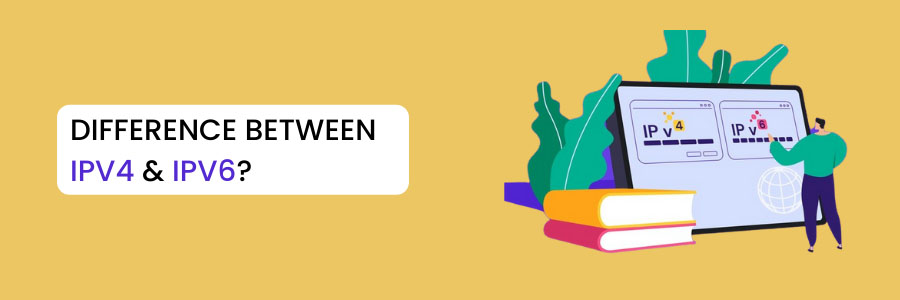What is the Difference Between IPv4 and IPv6?

In this article, we’ll be talking about What is the Difference Between IPv4 and IPv6? and What are IPv4 and IPv6.
The Internet Protocol Comparison of IPv4 and IPv6
The Internet Protocol allows computers and other devices to communicate across the internet (IP).
IPv4 and IPv6 are the two versions of IP currently in use. Both are used to identify networked devices, although they differ in important ways.
You’ll learn about the distinctions between IPv4 and IPv6, as well as the future of each internet protocol version, in this article
What Is an Internet Protocol?
The Internet Protocol (IP) is a collection of rules for routing data across networks and ensuring that it reaches its intended destination.
When transferring data across a network, a computer breaks the data into bits known as data packets, making the data transmission process quicker and more efficient.
The source and destination IP addresses are both included in each data packet. A unique identification provided to all devices connected to the internet or a computer network is known as an IP address.
In the same way that you need a postal address to send a letter, a device need a valid IP address to communicate data across a network.
Here’s an example of how IP addresses may appear:
212.1.212.62
The Internet Assigned Numbers Authority (IANA), a US-based agency in charge of administering the IP address pool, distributes IP addresses.
Remember that an IP address is not the same as a domain name, which is a website address that is easier to remember than a numerical IP address.
What Is IPv4?
IPv4 was the first version of IP to be used. IPv4 addresses are 32 bits long, which is the format you’re probably most familiar with when discussing an “IP address.” Although some IP blocks are reserved for special purposes, this 32-bit address space provides nearly 4.3 billion unique addresses.
Here’s an example of an IPv4 address:
32.253.431.175
What Is IPv6?
The IPv6 is a newer version of IP that uses a 128-bit address format and includes both numbers and letters. Here’s an example of an IPv6 address:
3002:0bd6:0000:0000:0000:ee00:0033:6778
Difference Between IPv4 and IPv6
Now that you’ve learned a little more about the two protocols, it’s time to compare and contrast IPv4 and IPv6.
Let’s take a look at the comparison table below.
| Differences | IPv4 | IPv6 |
| Size of address | 32-bit IP address. | 128-bit IP address. |
| Number of header fields | 12. | 8. |
| Length of the header field | 20 bytes. | 40 bytes. |
| Addressing method | IPv4 is based on a numeric address. | IPv6 is based on an alphanumeric address. |
| Type of addresses | Broadcast, multicast, and unicast. | Anycast, multicast, and unicast. |
| Checksum fields | Present. | Absent. |
| Number of classes | Five different classes, from class A to E. | Unlimited number of IP addresses. |
| Configuration | Users must configure a newly installed system to make IPv4 communicate with other systems. | Configuration is optional and depends on the functions needed. |
| Virtual length subnet mask (VLSM) support | It supports VLSM. | It doesn’t support VLSM. |
| Routing information protocol (RIP) | IPv4 is supported by RIPv1 and RIPv2. | IPv6 is supported by RIPng. |
| Network configuration | Networks are configured either manually or via dynamic host configuration protocol (DHCP). | IPv6 comes with auto-configuration capabilities. |
| Address features | IPv4 uses Network Address Translation (NAT), allowing a single NAT address to represent thousands of non-routable addresses. | IPv6 supports direct addressing because of its vast space of address. |
| Address mask | It’s used for the designated network from the host portion. | IPv6 doesn’t use an address mask. |
| Address configuration | Manually or via DHCP. | Stateless address autoconfiguration using the Internet Control Message Protocol version 6 (ICMPv6) or DHCPv6. |
| Packet size | 576 bytes of minimum packet size. | 1208 bytes of minimum packet size. |
| Packet fragmentation | It’s done by the sender and forwarding routers. | It’s done by only sender routers. |
| Packet header | IPv4 doesn’t identify packet flow for QoS handling, including checksum options. | Flow Label fields specify packet flow for QoS handling. |
| SNMP | Support included. | Not supported. |
| Mobility and interoperability | It uses relatively constrained network topologies, restricting mobility and interoperability capabilities. | IPv6 provides mobility and interoperability capabilities included in network devices. |
| DNS records | IPv4 features A records. | IPv6 features AAAA records. |
| Security | IPv4’s security depends on applications. | IPv6 has Internet Protocol Security (IPSec) out-of-the-box. |
| Local subnet group management | IPv4 uses Internet Group Management Protocol (IGMP). | IPv6 uses Multicast Listener Discovery (MLD). |
| Mapping | IPv4 utilizes Address Resolution Protocol (ARP). | IPv6 uses the Neighbor Discovery (ND) process for address resolution. |
| Mobile device compatibility | IPv4 addresses use dot-decimal notation, making them less suitable for mobile networks. | IPv6 addresses use hexadecimal and colon-separated notations. That’s why IPv6 is better suited to handle mobile networks. |
| Dynamic host configuration protocol(DHSP) | Users need to approach a DHCP when trying to connect to a network. | Users don’t need to contact any servers since they are given permanent addresses. |
| Optional fields | Present. | Absent, but it has extension headers instead. |
The Internet Protocol (IP) helps in the routing of data across networks. Each device is given an IP address in order to accomplish this. That’s all most people need to know – IPv6 has a different format and more unique addresses than IPv4.
